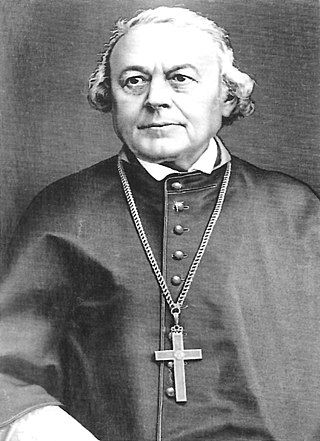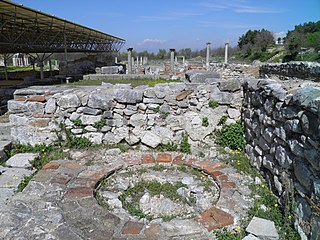
Pope Honorius I was the bishop of Rome from 27 October 625 to his death. He was active in spreading Christianity among Anglo-Saxons and attempted to convince the Celts to calculate Easter in the Roman fashion. He is chiefly remembered for his correspondence with Patriarch Sergius I of Constantinople over the latter's monothelite teachings. Honorius was posthumously anathematized, initially for subscribing to monothelitism, and later only for failing to end it. The anathema against Honorius I became one of the central arguments against the doctrine of papal infallibility.
Pope Boniface IV, OSB was the bishop of Rome from 608 to his death. Boniface had served as a deacon under Pope Gregory I, and like his mentor, he ran the Lateran Palace as a monastery. As pope, he encouraged monasticism. With imperial permission, he converted the Pantheon into a church. In 610, he conferred with Bishop Mellitus of London regarding the needs of the English Church. He is venerated as a saint in the Catholic Church with a universal feast day on 8 May.

The Second Council of Constantinople is the fifth of the first seven ecumenical councils recognized by both the Eastern Orthodox Church and the Catholic Church. It is also recognized by the Old Catholics and others. Protestant opinions and recognition of it are varied. Some Protestants, such as Calvinists, recognize the first four councils, whereas Lutherans and most Anglo-Catholics accept all seven. Constantinople II was convoked by the Byzantine Emperor Justinian I under the presidency of Patriarch Eutychius of Constantinople. It was held from 5 May to 2 June 553. Participants were overwhelmingly Eastern bishops—only sixteen Western bishops were present, including nine from Illyricum and seven from Africa, but none from Italy—out of the 152 total.

The Third Council of Constantinople, counted as the Sixth Ecumenical Council by the Eastern Orthodox and Catholic Churches, as well as by certain other Western Churches, met in 680–681 and condemned monoenergism and monothelitism as heretical and defined Jesus Christ as having two energies and two wills.

Pope Symmachus was the bishop of Rome from 22 November 498 to his death. His tenure was marked by a serious schism over who was elected pope by a majority of the Roman clergy.

Karl Josef von Hefele was a Roman Catholic bishop and theologian of Germany.
In the history of Christianity and later of the Roman Catholic Church, there have been several Councils of Aquileia. The Roman city of Aquileia at the head of the Adriatic Sea is the seat of an ancient episcopal see, seat of the Patriarch of Aquileia.

Isidore of Kiev, also known as Isidore of Thessalonica, was a prelate of Byzantine Greek origin. From 1437 to 1441 he served as the Metropolitan of Kiev and all Rus' in the patriarchate of Constantinople of the Eastern Orthodox Church. He was a supporter of the Union of Florence which he proclaimed in Hagia Sophia on 12 December 1452. In the Latin Church, Isidore was the cardinal bishop of Sabina, Archbishop of Cyprus, Camerlengo of the Sacred College of Cardinals and the Latin Patriarch of Constantinople.

Caesarius of Arles, sometimes called "of Chalon" from his birthplace Chalon-sur-Saône, was the foremost ecclesiastic of his generation in Merovingian Gaul. Caesarius is considered to be of the last generation of church leaders of Gaul who worked to integrate large-scale ascetic elements into the Western Christian tradition. William E. Klingshirn's study of Caesarius depicts Caesarius as having the reputation of a "popular preacher of great fervour and enduring influence". Among those who exercised the greatest influence on Caesarius were Augustine of Hippo, Julianus Pomerius, and John Cassian.
The First Council of Orange was held in the diocese of Orange, then part of the Western Roman Empire, in 441. The meeting took place in a church called the ecclesia Justinianensis, under the presidency of Bishop Hilary of Arles. Seventeen bishops attended the meeting, among them Bishop Eucherius of Lyons.
The Council of Agde was a regional synod held in September 506 at Agatha or Agde, on the Mediterranean coast east of Narbonne, in the Septimania region of the Visigothic Kingdom, with the permission of the Visigothic King Alaric II.
The First Council of Toledo was held at Toledo, Spain, in September of 400. The council was assembled under Archbishop Patronus with its primary purpose to condemn the Priscillian heresy, to receive back Priscillians, and uphold the Nicene Creed. Eighteen other Hispanic bishops participated, including Lampius, bishop of Barcelona. Many Priscillians were readmitted into the Catholic Church, notably Priscillian bishop Dictinnius. The council also reformed the clergy. Twenty canons were published by this council. It would be another 47 years before a council met again in Toledo.
The Fifth Council of Orléans assembled nine archbishops and forty-one bishops. Sacerdos of Lyon presided over this council. The presence of these bishops indicates both the wide spread of Christianity in Gaul by the sixth century, and the increased influence of the Merovingian kings.

The ancient residential diocese of Orange in the Comtat Venaissin in Provence, a fief belonging to the papacy, was suppressed by the French government during the French Revolution. It was revived in 2009 as a titular see of the Catholic Church.
The Second Council of Toledo was held by 8 bishops of the Visigothic Kingdom of Toledo in the city of Toledo in 527 or 531, under the presidency of Montanus (Montà), the metropolitan bishop of Toledo. The chief issue with which the synod dealt was Arianism. This council was the first in which Toledo was identified as a metropolitan see. Five new canons were decreed.
Saint Ephraim of Antioch, also known as Saint Ephraim of Amida, was the Patriarch of Antioch, and head of the Greek Orthodox Church of Antioch, from 527 until his death in 545. He is venerated as a saint in the Eastern Orthodox and Catholic Churches. His feast day is 8 June.
The Second Council of Orange was held in 529 at Orange, which was then part of the Ostrogothic Kingdom. It affirmed much of the theology of Augustine of Hippo and synergism, and made numerous proclamations against what later would come to be known as semi-Pelagian doctrine.
The Council or Synod of Soissons may refer to any of the following Catholic synods in Soissons, France:

The Metropolis of Philippi, Neapolis and Thasos is a Greek Orthodox metropolitan see in eastern Macedonia, Greece. It was founded in the ancient city of Philippi, where it was based until the destruction of the host city in the 14th or 15th century. Today it is based in the city of Kavala. Although being subject to the Ecumenical Patriarchate of Constantinople, it is administered by the Church of Greece.
Aré or Aregius of Nevers was bishop of Nevers in France and is known because he subscribed to the deeds of both the Fifth Council of Orléans, in 549 and the Second Synod of Paris in 551.








